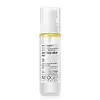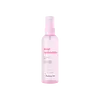What's inside
What's inside
 Key Ingredients
Key Ingredients

 Benefits
Benefits

 Concerns
Concerns

 Ingredients Side-by-side
Ingredients Side-by-side

Water
Skin ConditioningDipropylene Glycol
HumectantButylene Glycol
HumectantIsononyl Isononanoate
Emollient1,2-Hexanediol
Skin ConditioningGlycerin
HumectantNiacinamide
SmoothingBetaine
HumectantEthylhexylglycerin
Skin ConditioningOlea Europaea Fruit Oil
MaskingAdenosine
Skin ConditioningHippophae Rhamnoides Oil
EmollientPelargonium Graveolens Flower Oil
MaskingXanthan Gum
EmulsifyingPanthenol
Skin ConditioningCitrus Aurantium Dulcis Peel Oil
MaskingMentha Piperita Oil
MaskingLavandula Hybrida Oil
EmollientCitrus Aurantium Bergamia Fruit Oil
MaskingRose Flower Oil
MaskingChamomilla Recutita Flower Oil
MaskingHyaluronic Acid
HumectantSodium PCA
HumectantSodium Lactate
BufferingMacadamia Ternifolia Seed Oil
EmollientArginine
MaskingAspartic Acid
MaskingElaeis Guineensis Oil
EmollientPCA
HumectantCeramide NP
Skin ConditioningCholesterol
EmollientTuber Magnatum Extract
Skin ConditioningAdansonia Digitata Seed Oil
EmollientStearic Acid
CleansingPersea Gratissima Oil
Skin ConditioningPhytosphingosine
Skin ConditioningHydrolyzed Hyaluronic Acid
HumectantGlycine
BufferingAlanine
MaskingSodium Hyaluronate
HumectantSerine
MaskingValine
MaskingIsoleucine
Skin ConditioningThreonine
Proline
Skin ConditioningPhenylalanine
MaskingHistidine
HumectantDisodium EDTA
Water, Dipropylene Glycol, Butylene Glycol, Isononyl Isononanoate, 1,2-Hexanediol, Glycerin, Niacinamide, Betaine, Ethylhexylglycerin, Olea Europaea Fruit Oil, Adenosine, Hippophae Rhamnoides Oil, Pelargonium Graveolens Flower Oil, Xanthan Gum, Panthenol, Citrus Aurantium Dulcis Peel Oil, Mentha Piperita Oil, Lavandula Hybrida Oil, Citrus Aurantium Bergamia Fruit Oil, Rose Flower Oil, Chamomilla Recutita Flower Oil, Hyaluronic Acid, Sodium PCA, Sodium Lactate, Macadamia Ternifolia Seed Oil, Arginine, Aspartic Acid, Elaeis Guineensis Oil, PCA, Ceramide NP, Cholesterol, Tuber Magnatum Extract, Adansonia Digitata Seed Oil, Stearic Acid, Persea Gratissima Oil, Phytosphingosine, Hydrolyzed Hyaluronic Acid, Glycine, Alanine, Sodium Hyaluronate, Serine, Valine, Isoleucine, Threonine, Proline, Phenylalanine, Histidine, Disodium EDTA
Water
Skin ConditioningGlycerin
HumectantMethylpropanediol
SolventTriethyl Citrate
Masking1,2-Hexanediol
Skin ConditioningGlyceryl Glucoside
HumectantMethyl Gluceth-20
HumectantGlucose
HumectantC12-14 Alketh-12
EmulsifyingChlorella Vulgaris Extract
Skin ConditioningButylene Glycol
HumectantCaprylyl Glycol
EmollientFructooligosaccharides
HumectantFructose
HumectantOctyldodeceth-16
EmulsifyingPanthenol
Skin ConditioningEthylhexylglycerin
Skin ConditioningSodium Citrate
BufferingCitric Acid
BufferingParfum
MaskingCynanchum Atratum Extract
Skin ConditioningAlthaea Rosea Flower Extract
Skin ConditioningTocopherol
AntioxidantPropanediol
SolventMentha Aquatica Extract
TonicOpuntia Ficus-Indica Fruit Extract
Skin ConditioningCamellia Sinensis Seed Oil
HumectantYeast Ferment Extract
Skin ConditioningCandida Bombicola/Glucose/Methyl Rapeseedate Ferment
AntimicrobialWater, Glycerin, Methylpropanediol, Triethyl Citrate, 1,2-Hexanediol, Glyceryl Glucoside, Methyl Gluceth-20, Glucose, C12-14 Alketh-12, Chlorella Vulgaris Extract, Butylene Glycol, Caprylyl Glycol, Fructooligosaccharides, Fructose, Octyldodeceth-16, Panthenol, Ethylhexylglycerin, Sodium Citrate, Citric Acid, Parfum, Cynanchum Atratum Extract, Althaea Rosea Flower Extract, Tocopherol, Propanediol, Mentha Aquatica Extract, Opuntia Ficus-Indica Fruit Extract, Camellia Sinensis Seed Oil, Yeast Ferment Extract, Candida Bombicola/Glucose/Methyl Rapeseedate Ferment
Ingredients Explained
These ingredients are found in both products.
Ingredients higher up in an ingredient list are typically present in a larger amount.
1,2-Hexanediol is a synthetic liquid and another multi-functional powerhouse.
It is a:
- Humectant, drawing moisture into the skin
- Emollient, helping to soften skin
- Solvent, dispersing and stabilizing formulas
- Preservative booster, enhancing the antimicrobial activity of other preservatives
Butylene Glycol (or BG) is used within cosmetic products for a few different reasons:
Overall, Butylene Glycol is a safe and well-rounded ingredient that works well with other ingredients.
Though this ingredient works well with most skin types, some people with sensitive skin may experience a reaction such as allergic rashes, closed comedones, or itchiness.
Learn more about Butylene GlycolEthylhexylglycerin (we can't pronounce this either) is commonly used as a preservative and skin softener. It is derived from glyceryl.
You might see Ethylhexylglycerin often paired with other preservatives such as phenoxyethanol. Ethylhexylglycerin has been found to increase the effectiveness of these other preservatives.
Glycerin is already naturally found in your skin. It helps moisturize and protect your skin.
A study from 2016 found glycerin to be more effective as a humectant than AHAs and hyaluronic acid.
As a humectant, it helps the skin stay hydrated by pulling moisture to your skin. The low molecular weight of glycerin allows it to pull moisture into the deeper layers of your skin.
Hydrated skin improves your skin barrier; Your skin barrier helps protect against irritants and bacteria.
Glycerin has also been found to have antimicrobial and antiviral properties. Due to these properties, glycerin is often used in wound and burn treatments.
In cosmetics, glycerin is usually derived from plants such as soybean or palm. However, it can also be sourced from animals, such as tallow or animal fat.
This ingredient is organic, colorless, odorless, and non-toxic.
Glycerin is the name for this ingredient in American English. British English uses Glycerol/Glycerine.
Learn more about GlycerinPanthenol is a common ingredient that helps hydrate and soothe the skin. It is found naturally in our skin and hair.
There are two forms of panthenol: D and L.
D-panthenol is also known as dexpanthenol. Most cosmetics use dexpanthenol or a mixture of D and L-panthenol.
Panthenol is famous due to its ability to go deeper into the skin's layers. Using this ingredient has numerous pros (and no cons):
Like hyaluronic acid, panthenol is a humectant. Humectants are able to bind and hold large amounts of water to keep skin hydrated.
This ingredient works well for wound healing. It works by increasing tissue in the wound and helps close open wounds.
Once oxidized, panthenol converts to pantothenic acid. Panthothenic acid is found in all living cells.
This ingredient is also referred to as pro-vitamin B5.
Learn more about PanthenolWater. It's the most common cosmetic ingredient of all. You'll usually see it at the top of ingredient lists, meaning that it makes up the largest part of the product.
So why is it so popular? Water most often acts as a solvent - this means that it helps dissolve other ingredients into the formulation.
You'll also recognize water as that liquid we all need to stay alive. If you see this, drink a glass of water. Stay hydrated!
Learn more about Water